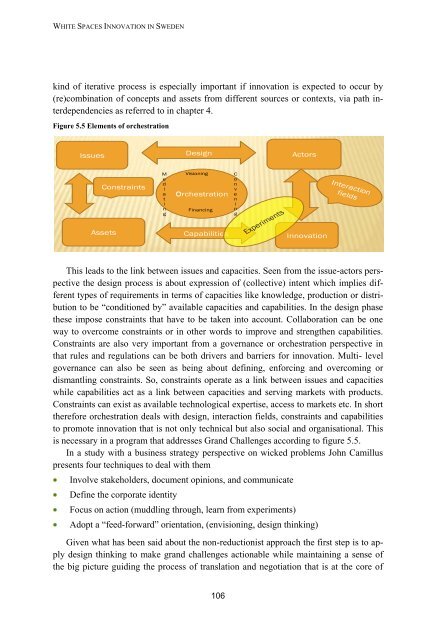White Spaces Innovation in Sweden - Innovation policy for ... - Vinnova
White Spaces Innovation in Sweden - Innovation policy for ... - Vinnova
White Spaces Innovation in Sweden - Innovation policy for ... - Vinnova
You also want an ePaper? Increase the reach of your titles
YUMPU automatically turns print PDFs into web optimized ePapers that Google loves.
WHITE SPACES INNOVATION IN SWEDENk<strong>in</strong>d of iterative process is especially important if <strong>in</strong>novation is expected to occur by(re)comb<strong>in</strong>ation of concepts and assets from different sources or contexts, via path <strong>in</strong>terdependenciesas referred to <strong>in</strong> chapter 4.Figure 5.5 Elements of orchestrationIssuesDesignActorsConstra<strong>in</strong>tsMediat<strong>in</strong>gVision<strong>in</strong>gOrchestrationF<strong>in</strong>anc<strong>in</strong>gConven<strong>in</strong>gAssetsCapabilities<strong>Innovation</strong>This leads to the l<strong>in</strong>k between issues and capacities. Seen from the issue-actors perspectivethe design process is about expression of (collective) <strong>in</strong>tent which implies differenttypes of requirements <strong>in</strong> terms of capacities like knowledge, production or distributionto be “conditioned by” available capacities and capabilities. In the design phasethese impose constra<strong>in</strong>ts that have to be taken <strong>in</strong>to account. Collaboration can be oneway to overcome constra<strong>in</strong>ts or <strong>in</strong> other words to improve and strengthen capabilities.Constra<strong>in</strong>ts are also very important from a governance or orchestration perspective <strong>in</strong>that rules and regulations can be both drivers and barriers <strong>for</strong> <strong>in</strong>novation. Multi- levelgovernance can also be seen as be<strong>in</strong>g about def<strong>in</strong><strong>in</strong>g, en<strong>for</strong>c<strong>in</strong>g and overcom<strong>in</strong>g ordismantl<strong>in</strong>g constra<strong>in</strong>ts. So, constra<strong>in</strong>ts operate as a l<strong>in</strong>k between issues and capacitieswhile capabilities act as a l<strong>in</strong>k between capacities and serv<strong>in</strong>g markets with products.Constra<strong>in</strong>ts can exist as available technological expertise, access to markets etc. In shortthere<strong>for</strong>e orchestration deals with design, <strong>in</strong>teraction fields, constra<strong>in</strong>ts and capabilitiesto promote <strong>in</strong>novation that is not only technical but also social and organisational. Thisis necessary <strong>in</strong> a program that addresses Grand Challenges accord<strong>in</strong>g to figure 5.5.In a study with a bus<strong>in</strong>ess strategy perspective on wicked problems John Camilluspresents four techniques to deal with themInvolve stakeholders, document op<strong>in</strong>ions, and communicateDef<strong>in</strong>e the corporate identityFocus on action (muddl<strong>in</strong>g through, learn from experiments)Adopt a “feed-<strong>for</strong>ward” orientation, (envision<strong>in</strong>g, design th<strong>in</strong>k<strong>in</strong>g)Given what has been said about the non-reductionist approach the first step is to applydesign th<strong>in</strong>k<strong>in</strong>g to make grand challenges actionable while ma<strong>in</strong>ta<strong>in</strong><strong>in</strong>g a sense ofthe big picture guid<strong>in</strong>g the process of translation and negotiation that is at the core of106
















